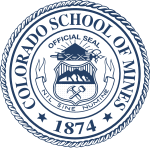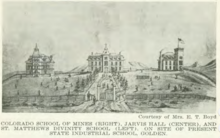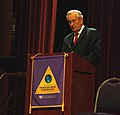Colorado School of Mines
 | |
| Motto | Nil sine numine (Latin) |
|---|---|
Motto in English | Nothing without God's will |
| Type | Public research university |
| Established | 1874 |
Academic affiliations | Space-grant |
| Endowment | $285.6 million (2020)[1] |
| President | Paul C. Johnson |
| Students | 7,172 (fall 2021)[2] |
| Undergraduates | 5,491 (fall 2021)[2] |
| Postgraduates | 1,681 (fall 2021)[2] |
| Location | , U.S. 39°45′4″N 105°13′21″W / 39.75111°N 105.22250°W |
| Campus | Suburban, 373 acres (1.51 km2)[3] |
| Colors | Blue & silver[4] |
| Nickname | Orediggers |
Sporting affiliations | NCAA Division II – Rocky Mountain |
| Mascot | Marvin the Miner Blaster the Burro[5] |
| Website | www |
| File:Wordmark of Colorado School of Mines.png | |
The Colorado School of Mines (informally Mines) is a public research university in Golden, Colorado, founded in 1874. The school offers both undergraduate and graduate degrees in engineering, science, and mathematics, with a focus on energy and the environment. While Mines does offer minor degrees in the humanities, arts, and social sciences, it only offers major degrees in STEM fields, with the exception of economics. In the Fall 2019 semester, the school had 6,607 students enrolled, with 5,155 in an undergraduate program and 1,452 in a graduate program.[2] The school has been co-educational since its founding, however, enrollment remains predominantly male (69.2% as of Fall 2020).[2] In every QS World University Ranking from 2016 to 2020, the university was ranked as the top institution in the world for mineral and mining engineering.[6] It is classified among "R1: Doctoral Universities – Very high research activity".[7]
History
Early history

Golden, Colorado, established in 1859 as Golden City, served as a supply center for miners and settlers in the area. In 1866, Bishop George M. Randall of Massachusetts arrived in the territory and, seeing a need for higher education facilities in the area, began planning for a university which would include a school of mines. In 1870, he opened the Jarvis Hall Collegiate School in the central building of the Colorado University Schools campus just south of the town of Golden, accompanied it with Matthews Hall divinity school in 1872, and in 1873 the School of Mines opened under the auspices of the Episcopal Church. In 1874 the School of Mines, supported by the territorial government since efforts began in 1870, was acquired by the territory and has been a state institution since 1876 when Colorado attained statehood. Tuition was originally free to residents of Colorado.[8]
Recent history

In August 2007, a new student recreation center was completed. In 2008, the school finished expanding its main computer center, the Center for Technology and Learning Media (CTLM). In May 2008 the school completed construction and installation of a new supercomputer nicknamed "Ra"[9] in the CTLM managed by the Golden Energy Computing Organization (GECO), a partnership among the Colorado School of Mines, the National Renewable Energy Laboratory, the National Center for Atmospheric Research and the National Science Foundation. In 2014, CoorsTek granted a $27 million investment to the university, leading to the 2017 opening of the CoorsTek Center for Applied Science and Engineering, a multi-disciplinary building on campus dedicated to both academic and research activities.[10]
Since 1964, the Colorado School of Mines has hosted the annual oil shale symposium, one of the most important international oil shale conferences. Although the series of symposia stopped after 1992, the tradition was restored in 2006.[11]
Presidents

- Chris Stell. – 1873[n 1]
- Gregory Board – 1875[n 1]
- Milton Moss – 1878[n 1]
- Albert C. Hale – 1880[n 2]
- Regis Chauvenet – 1883
- Charles S. Palmer – 1902
- Victor C. Alderson – 1903[n 3]
- William G. Haldane – 1913
- William B. Phillips – 1915
- Howard C. Parmelee – 1916
- Victor C. Alderson – 1917[n 3]
- Melville F. Coolbaugh – 1925
- Ben H. Parker – 1946
- John W Vanderwilt – 1950
- Orlo E. Childs – 1963
- Guy T. McBride, Jr. – 1970
- George S. Ansell – 1984
- Theodore A. Bickart – 1998
- John U. Trefny – 2000
- Myles W. Scoggins – 2006
- Paul C. Johnson – 2015
Campus

Colorado School of Mines is located to the southwest of Golden's downtown, bordered to the west by U.S. Route 6 and to the north by Clear Creek. The campus spans 373 acres (1.51 km2),[3] including over a dozen academic and research buildings, indoor and outdoor athletic facilities, two student centers, a library, eight residential halls, and administration buildings. Additionally, the campus hosts a research building for the United States Geological Survey,[12] housing the National Earthquake Information Center.

The school operates the free admission Mines Museum of Earth Science, which displays rock and mineral specimens collected from Colorado's numerous mining districts as well as around the world. Notable objects in the collection include one of the "Goodwill" Apollo 17 lunar samples and the Miss Colorado crown.[13][14]

The design of the university's buildings have varied widely over time, spanning a spectrum of styles from Second Empire to Postmodernist, created by noted Colorado architectural masters including Robert S. Roeschlaub (Hall of Engineering), Jacques Benedict (Steinhauer Field House), and Temple Hoyne Buell (Berthoud Hall). To date, three main academic buildings are gone (original Territorial School of Mines, 1871–93; Hall of Chemistry, 1880–1958; Paul Meyer Hall, 1963–2016), while the present campus includes:
- Alderson Hall
- Chemical and Biological Engineering
- Berthoud Hall
- Geology and Geological Engineering
- Brown Hall (Building)
- Engineering (Civil, Electrical, Mechanical, undergraduate Environmental)
- Computer Science
- Mining Engineering
- Chauvenet Hall
- Applied Math and Statistics
- Coolbaugh Hall
- Chemistry and Geochemistry
- CoorsTek Center for Applied Science and Engineering
- Physics
- Center for Technology and Learning Media (CTLM)
- Academic Computing and Networking
- Engineering Hall
- Economics and Business
- General Research Laboratory and Museum of Earth Science
- Green Center
- Geophysics
- GC Office of Events
- Guggenheim Hall
- President's Office (King PCJ)
- Administrative Offices
- Hill Hall
- Materials Science
- Metallurgical and Materials Engineering
- Arthur Lakes Library
- Library
- Marquez Hall
- Petroleum Engineering
- Moly Building
- Colorado Geological Survey
- Recreation Center
- Starzer Welcome Center
- Admissions
- Colorado School of Mines Alumni Association
- Colorado School of Mines Foundation
- Stratton Hall
- Humanities, Arts and Social Sciences
- Applied Math and Statistics (not primary location)
- Steinhauer Field House
- Student Center
- Financial Aid
- Bookstore
- Registrar
- Student Life
- Student Health Center
- U.S Geological Survey
- National Earthquake Information Center
- National Landslide Information Center
- Volk Gymnasium
- Physical Education and Athletics

Major open-air athletic facilities of the Colorado School of Mines include historic Campbell Field and Darden Field.
The honorary named Colorado School of Mines buildings commemorate Dr. Victor C. Alderson, Edward L. Berthoud, George R. Brown, Dr. Regis Chauvenet, Dr. Melville F. Coolbaugh, Cecil H. and Ida Green, Simon Guggenheim, Nathaniel P. Hill, Arthur Lakes, Dr. Paul D. Meyer, Winfield S. Stratton, and Russell K. Volk.
Academics

Mines is organized around 16 academic departments and 14 interdisciplinary programs:
- Advanced Manufacturing
- Advanced Energy Systems
- Applied Mathematics and Statistics
- Chemical and Biological Engineering
- Chemistry
- Civil and Environmental Engineering
- Computer Science
- Economics and Business
- Electrical Engineering
- Energy
- Engineering, Design and Society
- Geochemistry
- Geology and Geological Engineering
- Geophysics
- GIS and Geoinformatics
- Humanities, Arts and Social Sciences
- Mechanical Engineering
- Metallurgical and Materials Engineering
- Military Science/ROTC
- Mining Engineering
- Nuclear Science and Engineering
- Operations Research with Engineering
- Petroleum Engineering
- Physics
- Quantitative Biosciences and Engineering
- Space Resources
- Underground Construction and Tunneling
Mines began the world's first graduate program in space resources in the fall semester of 2018, offering both master's and PhD degrees.[16]
Rankings
| Academic rankings | |
|---|---|
| National | |
| Forbes[17] | 94 |
| U.S. News & World Report[18] | 88 |
| Washington Monthly[19] | 78 |
| WSJ/College Pulse[20] | 169 |
| Global | |
| ARWU[21] | 601–700 |
| THE[22] | 401–500 |
| U.S. News & World Report[23] | 503 |
|
USNWR departmental rankings[24] | |
|---|---|
| Chemistry | 96 |
| Computer Science | 91 |
| Earth Sciences | 28 |
| Engineering | 59 |
| Mathematics | 117 |
| Physics | 71 |
- Tied for 33rd in U.S. News & World Report's 2021 "Top Public Schools" in the U.S.[24]
- Second in U.S. News & World Report's 2021 "Best Engineering Graduate Schools" in the U.S.,[24] with the Petroleum Engineering program ranked fourth.[25]
- Tied for 83rd in U.S. News & World Report's 2021 "Best National Universities Rankings".[24]
- Third out of 174 schools ranked in Kiplinger's Personal Finance magazine's 2019 "Best Values in Public Colleges."[26]
- Ninth in "USA Today's Top 10 Engineering Schools 2015".[27]
Admissions
For freshmen entering Fall 2020, Colorado School of Mines received 11,756 applications, accepted 6,240 (53.1%) and enrolled 1,268 (11.1% of those who applied).[28] The middle 50% range of SAT scores for the enrolled freshmen was 620–710 for evidence-based reading, and 640–750 for math, while the ACT Composite range was 27–33.[28] The average GPA was 3.78. Of the incoming class, 21.2% were women.[28]
Traditions
M Climb
Freshmen at the Colorado School of Mines are expected, but not required, to participate in the M Climb during orientation weekend. During this climb, students carry a ten-pound rock brought from their hometown up Mt. Zion. Before ascending up the mountain, students are given colored hard-hats which are spray-painted by members of the Blue Key Honor Society.[29] Along the climb, non-freshmen encourage and heckle the new students with water balloons, silly string, and more, as well as leading the group in learning the Mines' fight song. At the top of the mountain, students place their rock on the "M," a large sign made of rock in the shape of Mines' M logo, and paint the M white using whitewash.[30] On graduation, seniors are invited to take a rock from the M as a keepsake of their time at Mines.[31]
Athletics
Colorado School of Mines was ranked No. 3 Best NCAA D2 school in the U.S. for student-athletes, according to Next College Student Athlete's 2018 NCSA Power Rankings.[32] The NCSA Power Rankings recognize the best colleges and universities in the U.S. for student-athletes.[33]
Notable alumni
-
Arden L. Bement Jr.
former director of the National Science Foundation (NSF) and the National Institute of Standards and Technology (NIST) -
Wendell Fertig
civil engineer, organized and commanded an American-Filipino guerrilla force on the Japanese-occupied Philippines during World War II -
Purnomo Yusgiantoro
president-secretary general of OPEC, former Indonesian Minister of Energy for three presidents, and former Minister of Defense in the Second United Indonesia Cabinet -
George Saunders Award-winning American writer of short stories, essays, novellas, children's books, and novels. Professor at Syracuse University.
Notable faculty
See also
Notes
References
- ^ As of June 30, 2020. U.S. and Canadian Institutions Listed by Fiscal Year 2020 Endowment Market Value and Change in Endowment Market Value from FY19 to FY20 (Report). National Association of College and University Business Officers and TIAA. February 19, 2021. Retrieved February 20, 2021.
- ^ a b c d e "Fall Headcount Enrollment". Colorado School of Mines. Retrieved August 21, 2020.
- ^ a b "Mines by the Numbers". Colorado School of Mines.
- ^ Mines Graphic Standards Guide (PDF). Archived from the original (PDF) on October 10, 2015. Retrieved September 14, 2016.
- ^ Blaster – Burro or Mule? Archived April 20, 2008, at the Wayback Machine
- ^ "QS World University Rankings by Subject 2020 – Engineering – Mineral & Mining". Top Universities. QS Quacquarelli Symonds. Retrieved December 13, 2020.
- ^ "Carnegie Classifications Institution Lookup". carnegieclassifications.iu.edu. Center for Postsecondary Education. 2022. Retrieved February 4, 2022.
- ^ Thomas, Grace Powers (1898). Where to educate, 1898–1899. A guide to the best private schools, higher institutions of learning, etc., in the United States. Boston: Brown and Company. p. 23. Retrieved August 17, 2012.
- ^ Mines unveils energy supercomputer 'Ra' Archived May 16, 2008, at the Wayback Machine
- ^ CoorsTek Center for Applied Science and Engineering - Campus TourArchived July 22, 2020, at the Wayback Machine
- ^ Purga, Jaanus (2006). "26th Oil Shale Symposium in Golden – waking up the largest oil shale reserve in the world" (PDF). Oil Shale. A Scientific-Technical Journal. 23 (4). Estonian Academy Publishers: 385–386. ISSN 0208-189X. Retrieved July 9, 2009.
- ^ "U.S. Geological Survey and Colorado School of Mines announce long-term partnership". Department of the Interior, U.S. Geological Survey. October 22, 2018. Retrieved August 20, 2020.
- ^ "MInes Museum - Campus Tour". tour.mines.edu. Colorado School of Mines. Retrieved August 20, 2020.
- ^ "Home - Mines Museum of Earth Science". mines.edu. Colorado School of Mines. Retrieved August 20, 2020.
- ^ "Alderson Hall". Jefferson County Place Names Directory. Retrieved October 2, 2016.
- ^ School Of Mines Debuts The world's first degree program for space mining, Colorado Public Radio, August 13, 2018. Retrieved August 17, 2018.
- ^ "Forbes America's Top Colleges List 2023". Forbes. Retrieved September 22, 2023.
- ^ "2023-2024 Best National Universities". U.S. News & World Report. Retrieved September 22, 2023.
- ^ "2023 National University Rankings". Washington Monthly. Retrieved February 10, 2024.
- ^ "2024 Best Colleges in the U.S." The Wall Street Journal/College Pulse. Retrieved January 27, 2024.
- ^ "ShanghaiRanking's 2023 Academic Ranking of World Universities". Shanghai Ranking Consultancy. Retrieved February 10, 2024.
- ^ "World University Rankings 2024". Times Higher Education. Retrieved September 27, 2023.
- ^ "2022-23 Best Global Universities Rankings". U.S. News & World Report. Retrieved February 25, 2023.
- ^ a b c d "Colorado School of Mines Rankings". U.S. News & World Report. 2021. Retrieved October 12, 2020.
- ^ "Best Petroleum Engineering Programs". U.S. News & World Report. 2021. Retrieved October 12, 2020.
- ^ "Colorado School of Mines Ranking". Kiplinger's Personal Finance. July 2019.
- ^ "The top 10 engineering colleges in the U.S." USA Today. Archived from the original on October 11, 2015. Retrieved May 26, 2017.
- ^ a b c "Colorado School of Mines Common Data Set 2019–2020, Part C" (PDF). Colorado School of Mines.
- ^ Rusch, Emilie (August 13, 2019). "Incoming students to kick off academic year with M Climb". Mines Newsroom. Retrieved July 25, 2020.
- ^ White, Mekialaya (August 17, 2019). "School Of Mines Freshmen Tackle 'M Climb' Tradition". CBS Denver. Retrieved July 25, 2020.
- ^ "History and Traditions". Colorado School of Mines. Archived from the original on April 26, 2020. Retrieved April 26, 2020.
- ^ "NCAA Division 2 Colleges, NCSA College Power Rankings 2018". NCSA College Power Ranking Report. Retrieved February 14, 2019.
- ^ "NCSA College Power Rankings of Top Athletic & Academic Universities". NCSA College Power Ranking Report. Retrieved February 12, 2019.
External links
- Colorado School of Mines
- Public universities and colleges in Colorado
- Schools of mines in the United States
- Technological universities in the United States
- Buildings and structures in Golden, Colorado
- Education in Jefferson County, Colorado
- Geology of Colorado
- Mines in Colorado
- Educational institutions established in 1874
- 1874 establishments in Colorado Territory
- Tourist attractions in Golden, Colorado









